Hyperinflation Special Report (Update 2010)
Update: March 15th, 2011:
A fully updated, "2011" version of this Hyperinflation Report has been published: Hyperinflaton Special Report (Update 2011)
HYPERINFLATION SPECIAL REPORT (UPDATE 2010)
Commentary Number 263
December 2, 2009
__________
Economy and Financial System Face Eventual Great Collapse
Government and Fed Actions Have Narrowed Timing for
Hyperinflationary Great Depression to Next Five Years
High Risk of Ultimate Dollar Crisis Unfolding in Year Ahead
__________
Please Note: Given less than one month before the New Year and the possible breaking of the hyperinflation crisis in the year ahead, I have entitled this "Update 2010." The report is intended to replace the Hyperinflation Special Report of April 8, 2008, which was published post-Bear Stearns but pre-Lehman, pre-TARP, pre-recession recognition and pre-2008 election. Nonetheless, the outlook has changed little. In turn, the April 2008 report updated and expanded upon the three-part Hyperinflation Series that began with the December 2006 SGS Newsletter.
The new missive includes much of the text in the prior edition, with revisions and updates reflecting the still-unfolding economic and systemic solvency crises, and it expands upon some areas touched upon in the previous report. SGS Special Reports published subsequent to April 2008 have supplemented the hyperinflation story and are incorporated by reference in this update: Money Supply Special Report (August 3, 2008), Depression Special Report (August 1, 2009), Consumer Liquidity Special Report (September 14, 2009).
Overview
A Great Collapse. The U.S. economic and systemic solvency crises of the last two years are just precursors to a Great Collapse: a hyperinflationary great depression. Such will reflect a complete collapse in the purchasing power of the U.S. dollar, a collapse in the normal stream of U.S. commercial and economic activity, a collapse in the U.S. financial system as we know it, and a likely realignment of the U.S. political environment. The current U.S. financial markets, financial system and economy remain highly unstable and vulnerable to unexpected shocks. The Federal Reserve is dedicated to preventing deflation, to debasing the U.S. dollar. The results of those efforts are being seen in tentative selling pressures against the U.S. currency and in the rallying price of gold.
Crises Brewed by Federal Government and Federal Reserve Malfeasance. The crises have been generated out of and are centered on the United States financial system, triggered by the collapse of debt excesses actively encouraged by the Greenspan Federal Reserve. Recognizing that the U.S. economy was sagging under the weight of structural changes created by government trade, regulatory and social policies — policies that limited real consumer income growth — Mr. Greenspan played along with the political and banking systems. He made policy decisions to steal economic activity from the future, fueling economic growth of the last decade largely through debt expansion.
The Greenspan Fed pushed for ever-greater systemic leverage, including the happy acceptance of new financial products, which included instruments of mis-packaged lending risks, designed for consumption by global entities that openly did not understand the nature of the risks being taken. Complicit in this broad malfeasance was the U.S. government, including both major political parties in successive Administrations and Congresses.
As with consumers, the federal government could not make ends meet while appeasing that portion of the electorate that could be kept docile by ever-expanding government programs and increasing government spending. The solution was ever-expanding federal debt and deficits.
Purportedly, it was Arthur Burns, Fed Chairman under Richard Nixon, who first offered the advice that helped to guide Alan Greenspan and a number of Administrations. The gist of the wisdom imparted was that if you ran into problems, you could ignore the budget deficit and the dollar. Ignoring them did not matter, because doing so would not cost you any votes.
Back in 2005, I raised the issue of a then-inevitable U.S. hyperinflation with an advisor to both the Bush Administration and Fed Chairman Greenspan. I was told simply that "It’s too far into the future to worry about."
Indeed, pushing the big problems into the future appears to have been the working strategy for both the Fed and recent Administrations. Yet, the U.S. dollar and the budget deficit do matter, and the future is at hand. The day of ultimate financial reckoning has arrived, and it is playing out.
Saving the System at Any Cost. The Federal Reserve and the U.S. Treasury moved early in the current solvency crisis to prevent a collapse of the banking system, at any cost. It was the collapse of the banking system and loss of depositor assets in the early-1930s that intensified the Great Depression and its attendant deflation. A somewhat parallel risk was envisioned in 2008 as the system passed over the brink. The decision was made to avoid a deflationary great depression.
Effective financial impairments and at least partial nationalizations or orchestrated bailouts/takeovers resulted for institutions such as Bear Stearns, Citigroup, Washington Mutual, AIG, General Motors, Chrysler, Fannie Mae and Freddie Mac, along with a number of further troubled financial institutions. The Fed moved to provide whatever systemic liquidity would be needed, while the federal government moved to finance corporate bailouts and to introduce significant stimulus spending.
Curiously, though, the Fed and the Treasury let Lehman Brothers fail outright, which triggered a foreseeable run on the system and markedly intensified the systemic solvency crisis in September 2008. Whether someone was trying to play political games, with the public and Congress increasingly raising questions of moral hazard issues, or whether the U.S. financial wizards missed what would happen or simply moved to bring the crisis to a head, remains to be seen.
In the midst of the crises, the Obama Administration has introduced major new government programs, ranging from carbon tax plans to a national health care and insurance program. Irrespective of any stated goals of not increasing the federal deficit further, these programs will have severely negative impact on the federal deficit, either from massive net expenses, or from losses in tax revenues in a weaker economy. The various initiatives generally will act as major depressants on business activity. The U.S. Treasury has delayed publishing the U.S. Government’s 2009 GAAP-based financial statements for two months, until February 2010. With my estimate of a GAAP-based 2009 annual deficit of roughly $9 trillion, there may some method in pushing off unhappy accounting until after the health-care package is resolved.
While the system will be saved at any cost, and the government will spend whatever it can spend until the financial markets rebel, the ultimate cost here will be in inflation and the increasing debasement of the purchasing power of the U.S. Dollar.
Hyperinflation Nears. Before the systemic solvency crisis began to unfold in 2007, the U.S. government already had condemned the U.S. dollar to a hyperinflationary grave by taking on debt and obligations that never could be covered through raising taxes and/or by severely slashing government spending that had become politically untouchable. The U.S. economy also already had entered a severe structural downturn, which helped to trigger the systemic solvency crisis.
The intensifying economic and solvency crises, and the responses to both by the U.S. government and the Federal Reserve in the last two years, have exacerbated the government’s solvency issues and moved forward my timing estimation for the hyperinflation to the next five years, from the 2010 to 2018 timing range estimated in the prior report. The U.S. government and Federal Reserve already have committed the system to this course through the easy politics of a bottomless pocketbook, the servicing of big-moneyed special interests, gross mismanagement, and a deliberate and ongoing effort to debase the U.S. currency. Accordingly, risks are particularly high of the hyperinflation crisis breaking within the next year.
Numerous foreign governments have offered unusually blunt criticism of U.S. fiscal and Federal Reserve policies in the last year. Both private and official demand for U.S. Treasuries increasingly is unenthusiastic. Looming with uncertain timing is a panicked dollar dumping and dumping of dollar-denominated paper assets. Such is the most likely event to trigger the onset of hyperinflation in the year ahead.
The U.S. has no way of avoiding a financial Armageddon. Bankrupt sovereign states most commonly use the currency printing press as a solution to not having enough money to cover obligations. The alternative would be for the U.S. to renege on its existing debt and obligations, a solution for modern sovereign states rarely seen outside of governments overthrown in revolution, and a solution with no happier ending than simply printing the needed money. With the creation of massive amounts of new fiat dollars (not backed by gold or silver) will come the eventual destruction of the value of the U.S. dollar and related dollar-denominated paper assets.
What lies ahead will be extremely difficult, painful and unhappy times for many in the United States. The functioning and adaptation of the U.S. economy and financial markets to a hyperinflation likely would be particularly disruptive. Trouble could range from turmoil in the food distribution chain to electronic cash and credit systems unable to handle rapidly changing circumstances. The situation quickly would devolve from a deepening depression, to an intensifying hyperinflationary great depression.
While the economic difficulties would have global impact, the initial hyperinflation should be largely a U.S. problem, albeit with major implications for the global currency system. For those living in the United States, long-range strategies should look to assure safety and survival, which from a financial standpoint means preserving wealth and assets. Also directly impacted, of course, are those holding or dependent upon U.S. dollars or dollar-denominated assets, and those living in "dollarized" countries.
The balance of this special report is broken into the following sections:
- Defining the Components of a Hyperinflationary Great Depression
- Two Examples of Hyperinflation
- Current Economic and Inflation Conditions in the United States
- Historical U.S. Inflation: Why Hyperinflation Instead of Deflation
- U.S. Government Cannot Cover Existing Obligations
- Hyperinflationary Great Depression
- Closing Comments
Defining the Components of a Hyperinflationary Great Depression
Deflation, Inflation and Hyperinflation. Inflation broadly is defined in terms of a rise in general prices due to an increase in the amount of money in circulation. The inflation/deflation issues defined and discussed here are as applied to goods and services, not to the pricing of financial assets.
In terms of hyperinflation, there have been a variety of definitions used over time. The circumstance envisioned ahead is not one of double- or triple- digit annual inflation, but more along the lines of seven- to 10-digit inflation seen in other circumstances during the last century. Under such circumstances, the currency in question becomes worthless, as seen in Germany (Weimar Republic) in the early 1920s, in Hungary after World War II, in the dismembered Yugoslavia of the early 1990s and most recently, in Zimbabwe where the pace of hyperinflation may have been the most extreme ever seen.
The historical culprit generally has been the use of fiat currencies — currencies with no hard-asset backing such as gold — and the resulting massive printing of currency that the issuing authority needed to support its spending, when it did not have the ability, otherwise, to raise enough money for its perceived needs, through taxes or other means.
Ralph T. Foster (hereinafter cited as Foster) in Fiat Paper Money, The History and Evolution of Our Currency (see recommended further reading at the end of this report) details the history of fiat paper currencies from 11th century Szechwan, China, to date, and the consistent collapse of those currencies, time-after-time, due to what appears to be the inevitable, irresistible urge of issuing authorities to print too much of a good thing. The United States is no exception, already having obligated itself to liabilities well beyond its ability ever to pay off.
Here are the definitions:
Deflation: A decrease in the prices of goods and services, usually tied to a contraction of money in circulation. Formal deflation is measured in terms of year-to-year change.
Inflation: An increase in the prices of goods and services, usually tied to an increase of money in circulation.
Hyperinflation: Extreme inflation, minimally in excess of four-digit annual percent change, where the involved currency becomes worthless. A fairly crude definition of hyperinflation is a circumstance, where, due to extremely rapid price increases, the largest pre-hyperinflation bank note ($100 bill in the United States) becomes worth more as functional toilet paper/tissue than as currency.
As discussed in the section on "Historical U.S. Inflation," the domestic economy has been through periods of both major inflation and deflation, usually tied to wars and their aftermaths. Such, however, preceded the U.S. going off the domestic gold standard in 1933 and abandoning international convertibility in 1971. The era of the modern fiat dollar generally has been one of persistent and slowly debilitating inflation.
Recession, Depression and Great Depression. A couple of decades back, I tried to tie down the definitional differences between a recession, depression and a great depression with the Bureau of Economic Analysis (BEA), the National Bureau of Economic Research (NBER) and a number of private economists. I found that there was no consensus on the matter, where popular usage of the term "depression" had taken on the meaning of a severe recession, so I set some definitions that the various parties (neither formally nor officially) thought were within reason.
If you look at the plot of the level of economic activity during a downturn, you will see something that looks like a bowl, with activity recessing on the downside and recovering on the upside. The term used to describe this bowl-shaped circumstance before World War II was "depression," while the downside portion of the cycle was called "recession," and the upside was called "recovery." Before World War II, all downturns simply were referred to as depressions. In the wake of the Great Depression of the 1930s, however, a euphemism was sought for future economic contractions so as to avoid evoking memories of that earlier, financially painful time.
Accordingly, a post-World War II downturn was called "recession." Officially, the worst post-World War II recession was from November 1973 through March 1975, with a peak-to-trough contraction of 5%. Such followed the Vietnam War, Nixon’s floating of the U.S. dollar and the Oil Embargo. The double-dip recession in the early-1980s may have seen a combined contraction of roughly 6%. I contend that the current double-dip recession that began in late-2000 already has surpassed the 1980s double-dip as to depth. (See the Reporting/Market Focus of the October 2007 SGS and the Depression Special Report for further detail.) Here are the definitions:
Recession:Two or more consecutive quarters of contracting real (inflation-adjusted) GDP, where the downturn is not triggered by an exogenous factor such as a truckers’ strike. The NBER, which is the official arbiter of when the United States economy is in recession, attempts to refine its timing calls, on a monthly basis, through the use of economic series such as payroll employment and industrial production, and it no longer relies on the two quarters of contracting GDP rule.
Depression:A recession, where the peak-to-trough contraction in real growth exceeds 10%.
Great Depression:A depression, where the peak-to-trough contraction in real growth exceeds 25%.
On the basis of the preceding, there has been the one Great Depression, in the 1930s. Most of the economic contractions before that would be classified as depressions. All business downturns since World War II — as officially reported — have been recessions. Using a the somewhat narrower "great depression" definition of a contraction in excess of 20% (instead of 25%), the depression of 1837 to 1843 would be considered "great," as would be the war-time production shut-down in 1945, at least technically.
Two Examples of Hyperinflation
Weimar Republic. Ralph Foster closes his book’s preface with a particularly poignant quote from a 1993 interview of Friedrich Kessler, a law professor whose university affiliations included, among others, Harvard and University of California Berkeley. From firsthand experience, Kessler described the Weimar Republic hyperinflation:
"It was horrible. Horrible! Like lightning it struck. No one was prepared. You cannot imagine the rapidity with which the whole thing happened. The shelves in the grocery stores were empty. You could buy nothing with your paper money."
The hyperinflation in Germany’s Weimar Republic is along the lines of what likely will unfold in the United States. The following two graphs plot the same numbers, but on different scales. The data are the monthly averages of the number of paper German marks that equaled one dollar (gold-backed) in 1922 and 1923, with that number acting as something of a surrogate for the pace of inflation.
The first plot is a simple arithmetic plot, but the earlier detail is masked by the extreme numbers of the last several months, suggestive of an extraordinarily rapid and large rise in the pace of inflation. The second plot is on a logarithmic scale, where each successive power of ten represents the next tick mark on the vertical scale.
While the hyperinflation did hit rapidly, annual inflation in January 1922 already was more than 200%, up from as low as 6% in April 1921. The existing currency was abandoned at the end of 1923.
Milton Friedman and Anna Jacobson Schwartz noted in their classic A Monetary History of the United States that the early stages of the Weimar Republic hyperinflation was accompanied by a huge influx of foreign capital, much as had happened during the U.S. Civil War. The speculative influx of capital into the U.S. at the time of the Civil War inflation helped to stabilize the system, as the foreign capital influx into the U.S. in recent years has helped to provide relative stability and strength to the equity and credit markets. Following the Civil War, however, the underlying U.S. economy had significant untapped potential and was able to generate strong, real economic activity that covered the war’s spending excesses.
Post-World War I Germany was a different matter, where the country was financially and economically depleted as a penalty for losing the war. Here, after initial benefit, the influx of foreign capital helped to destabilize the system. "As the mark depreciated, foreigners at first were persuaded that it would subsequently appreciate and so bought a large volume of mark assets …" Such boosted the foreign exchange value of the German mark and the value of German assets. "As the German inflation went on, expectations were reversed, the inflow of capital was replaced by an outflow, and the mark depreciated more rapidly … (Friedman p. 76)."
Indeed, in the wake of its defeat in the Great War, Germany was forced to make debilitating reparations to the victors — particularly France — as well as to face loss of territory. From Foster (Chapter 11):
"By late 1922, the German government could no longer afford to make reparations payments. Indignant, the French invaded the Ruhr Valley to take over the production of iron and coal (commodities used for reparations). In response, the German government encouraged its workers to go on strike. An additional


issue of paper money was authorized to sustain the economy during the crisis. Sensing trouble, foreign investors abruptly withdrew their investments.
"During the first few months of 1923, prices climbed astronomically higher, with no end in sight… The nation was effectively shut down by currency collapse. Mailing a letter in late 1923 cost 21,500,000,000 marks."
The worthless German mark became useful as wall paper and toilet paper, as well as for stoking fires.
The Weimar circumstance, and its heavy reliance on foreign investment, was closer to the current U.S. situation than it was to the U.S. Civil War experience. In certain aspects, the current U.S. situation is even worse than the Weimar situation. It certainly is worse than the Civil war circumstance.
Unlike the untapped economic potential of the United States 145 years ago, today’s U.S. economy is languishing in the structural problems of the loss of its manufacturing base and a shift of domestic wealth offshore; it is mired in an economic contraction that is immune to traditional economic stimuli. As the U.S. government has attempted in recent decades to assuage electorate discontent with ever more expensive social programs; as the Federal Reserve has moved to encourage debt expansion as a remedy for lack of real, inflation-adjusted, income growth; the eventual bankruptcy of the U.S. dollar was locked in. The problem here was taken on and created willingly by U.S. government officials — embraced by both major political parties — not imposed by a victorious and vengeful enemy of war.
In the early 1920s, foreign investors in Germany were not propping up the world’s reserve currency in an effort to prevent a global financial collapse, and they did not know in advance that they were doomed to take a large hit on their German investments. In today’s environment, both central banks and major private investors know that the U.S. dollar will be a losing proposition. They either expect and/or hope that they can get out of the dollar in time to avoid losses, or, in the case of the central banks, that they can forestall the ultimate global economic crisis. Such expectations and hopes have dimmed markedly in the last two years, as the untenable U.S. fiscal condition has gained more public and global recognition.
Zimbabwe. Hyperinflation in Zimbabwe, the former Rhodesia, was a quadrillion times worse than it was in Weimar Germany. Zimbabwe went through a number of years of high inflation, with an accelerating hyperinflation from 2006 to 2009, when the currency was abandoned. Through three devaluations, excess zeros repeatedly were lopped off notes as high as 100 trillion Zimbabwe dollars.

The cumulative devaluation of the Zimbabwe dollar was such that a stack of 100,000,000,000,000,000,000,000,000 (26 zeros) two dollar bills (if they were printed) in the peak hyperinflation would have be needed to equal in value what a single original Zimbabwe two-dollar bill of 1978 had been worth. Such a pile of bills literally would be light years high, stretching from the Earth to the Andromeda Galaxy.
In early-2009, the governor of the Zimbabwe Reserve Bank indicated he felt his actions in printing money were vindicated by the recent actions of the U.S. Federal Reserve. If the U.S. went through a hyperinflation like that of Zimbabwe’s, total U.S. federal debt and obligations (roughly $75 trillion with unfunded liabilities) could be paid off for much less than a current penny.
This image of a sign in a restroom facility at a South African border station with Zimbabwe speaks for itself.

What helped to enable the evolution of the Zimbabwe monetary excesses over the years, while still having something of a functioning economy, was the back-up of a well functioning black market in U.S. dollars. The United States has no such backup system, however, with implications for a more rapid and disruptive hyperinflation than seen in Zimbabwe, when it hits. This will be discussed later.
Current Economic and Inflation Conditions in the United States
Economic Activity and Inflation. Before examining how the current circumstance can evolve from a severe recession, with a recent short and shallow bout with formal deflation, into a hyperinflationary great depression, it is worth defining the nature of the current economic and inflation conditions in the United States and likely near-term developments.
As discussed in the regular SGS Commentaries, the U.S. economy remains in a structural recession/ depression, where recession recognition as of December 2007 became official following the prior hyperinflation report. At the same time, due to extreme fluctuations in oil prices, where an oil-price collapse eliminated oil-induced inflation pressures building at the time of the prior report, consumer inflation experienced a brief and shallow dip into official (year-to-year) deflation, through the October 2009 CPI. The November CPI will resume positive annual inflation, partially due to a renewed upturn in oil prices.
The current downturn, as reported, already is the longest and the deepest business contraction since the first downleg of the Great Depression in the early 1930s. Such is reflected in payroll employment and GDP growth plotted in the following graphs. The payroll graph adjusts for the size of the recently announced pending benchmark revision to the series. The quarterly GDP numbers are published only back to 1947. If one counts the war production shutdown at the end of World War II as a normal business cycle, then the current downturn is the deepest since then, but still the longest since the early 1930s. The respective depths of the Great Depression and post-war production contractions are based on annual data available back to 1929.
While the official peak-to-trough contraction in the current downturn, per official real GDP is 3.8% (second-quarter 2009), most of the better economic series are showing contractions of greater than 10% (depression range), such as retail sales and industrial production, while others are showing contractions of greater than 25% (great depression range), such as new orders for durable goods and various statistics indicating the level of housing activity. Revisions to the GDP over several years eventually should show the current level of GDP activity to have been at depression level. The evolving depression quickly will move to great depression status, at such time as the hyperinflation hits, since that will be extremely disruptive to the conduct of normal commerce.
Net of gimmicked methodologies that have inflated GDP reporting over the decades, the U.S. economy has been in recession since late-2006, entering the second down-leg of a multiple-dip economic contraction, where the first downleg was the recession of 2001, which actually began back in late-1999. The current downturn may evolve into a further multiple-dip circumstance. The Great Depression was a double-dip contraction. (See the Reporting/Market Focus of the October 2007 SGS and the Depression Special Report for further detail.)
The current economic downturn has been so protracted and severe that regular year-to-year comparisons and the seasonal adjustment process have forced new types of analyses and have led to major warping of regular economic reporting. Where a number of series, again, such as retail sales and industrial production, have leveled off at low-level plateaus of economic activity, year-ago comparisons have become less negative, but there has been no meaningful pick-up in economic activity.
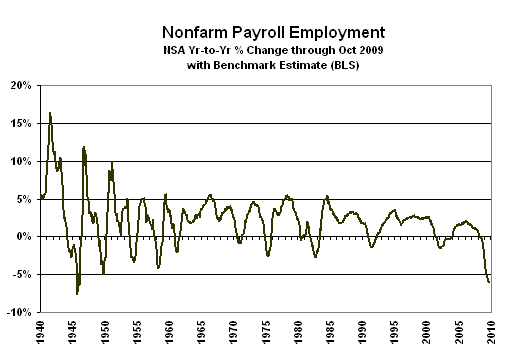
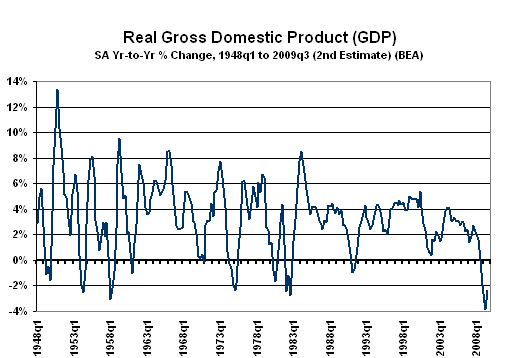
Economic activity has sunk to such lows that regular measures of change that are followed closely by the financial markets — such as new claims for unemployment insurance — are not signaling economic recovery, as they turn less negative, only that activity is beginning to plateau at an unusually low level. With stimulus packages having had their initial impacts, with broad domestic liquidity (see money supply discussion) contracting at a pace that would promise an economic downturn in the best of times, and with consumers’ liquidity problems intensifying, the contraction in U.S. economic activity likely will accelerate anew in the early months of 2010.
Consumer Liquidity Structural Problems. The U.S. economy is in a deepening structural change that has resulted from U.S. trade, social and regulatory policies driving a goodly portion of the U.S. manufacturing and technology base offshore. As a result, a large number of related, high paying jobs have disappeared for U.S. workers. Accordingly, U.S. consumers have found increasingly that their household incomes fail to keep up with inflation. Without real growth in income, there cannot be sustained economic growth. Growth driven by debt expansion, as encouraged by the Fed in recent years, ultimately is not sustainable, as has become painfully obvious to many in the current systemic solvency crisis. Greater detail on these and related comments are found in the Consumer Liquidity Special Report.
As shown in the next graph, the U.S. trade deficit has narrowed in the current downturn, with lowered U.S. consumption and with a brief collapse in oil prices. There has been, however, no fundamental shift in circumstances to suggest a healthy move in U.S. economic activity towards a fundamentally improved trade balance or a shift towards reinvigorating the U.S. manufacturing base.
The deterioration in median household income has resulted in greater variance in income, as shown in the second graph, which has negative longer term economic implications. A person earning $100,000,000 per year is not going to buy that many more automobiles that someone earning $100,000 per year. The stronger the middle class is, generally the stronger will be the economy. Historically, extremes in income variance usually are followed by financial panics and economic depressions. Income variance today is higher than it was coming into 1929 and 1987, and it is nearly double that of any other "advanced" economy.
The next two graphs show official weakness in inflation-adjusted income. The top plot of the solid line shows real average weekly earnings, as reported and deflated by the Bureau of Labor Statistics (BLS) using the regular CPI-W. Real wages never have recovered their pre-1973 to 1975 recession peak. As wages dropped over the decades, the number of people in an average household that had to work, in order to make ends meet, increased.
The second graph reflects median household income over the years. The thicker line shows income deflated by the regular CPI-U, a measure somewhat broader than the CPI-W. Those inflation-adjusted numbers show that median household income, as of 2008, never recovered its pre-2001 recession peak and stood below its level of 1973. Deflated by the CPI-U-RS (current methods), discussed below, the pre-2001 recession peak also still has not been recovered.
In the last several decades, the BLS introduced a variety of new methodologies into the calculation of the CPI, with the effect of reducing the level of reported CPI inflation. The general approach has been to move the CPI away from its traditional measuring of the cost of living of maintaining a constant standard of living. The lower the rate of inflation used in deflating a number, the stronger is the resulting inflation-adjusted growth. The CPI-U-RS is the CPI with its history restated as if all the new methodologies had



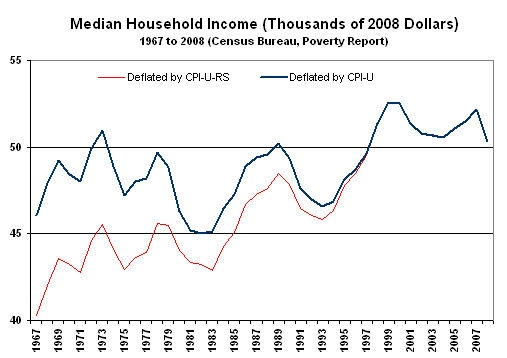
been in place from day one. The impact of the changes is evident in the two lines, with the thinner CPI-U-RS deflated line showing stronger relative growth. It would run higher than the top line if the years set equal were 1967 instead of 2008.
The broad point on income is that it is inadequate to sustain positive, inflation-adjusted economic activity. In the absence of income growth, debt expansion can act as a short-term prop for the economy, but that is not available at present. The system is in the throes of a solvency crisis, with banks reducing lending to consumers.
The broad point on the inflation measure is that by reverse-engineering the CPI-U-RS, current inflation reporting can be estimated as though it were free of the inflation-dampening methodologies. Such has been done with the SGS-Alternate Consumer Inflation Measure. In the plot of the real average weekly earnings, the dotted line reflects the series deflated by the SGS-Alternate CPI, and that shows the consumers’ liquidity squeeze to be more severe for those hoping to maintain a constant standard of living, than as indicated otherwise by official reporting.
Inflation. Inflationary pressures have started to surface from the Fed’s efforts at dollar debasement. A weakening U.S. dollar has placed upside pressure on dollar-denominated oil prices, which in turn have begun pushing annual inflation higher. This is not inflation generated by strong economic demand, but rather inflation driven by Federal Reserve efforts to weaken the dollar.

Though still well shy of the peak levels seen in 2008, oil and gasoline prices have soared since their near-term lows at the end of last year. The relative collapse, in latter 2008, of gasoline and oil prices triggered a period of year-to-year decline — formal deflation — in the CPI-U. Now with relatively high prices going against falling prices in year-ago comparisons, annual CPI inflation will turn positive, once more, as of November. As reported by the BLS, annual CPI-U inflation for October 2009 was not statistically distinguishable from zero; the SGS-Alternate Consumer Inflation Measure was about 7.1%.
For all of 2009, CPI-U average annual inflation should be less than a 0.5% contraction (deflation), with the SGS-Alternate at something shy of 7%. As measured December 2009 over December 2008, official annual CPI-U inflation should be close to 2% with the SGS-Alternate around 9%. A strengthening pick-up in official annual CPI inflation should be evident in early 2010.
The recent annual declines in CPI inflation were the biggest since 1949 to 1950. CPI reporting methods used in then, however, would have generated current inflation rates that did not drop below 5%, at worst, in the current cycle. The brief and shallow formal deflation that now is at an end — based on official CPI-U reporting — appears to have been about half the depth and half the length of the negative inflation bout in the 1949 to 1950 circumstance.
The SGS-Alternate Consumer Inflation Measure adjusts on an additive basis for the cumulative impact on the annual inflation rate of various methodological changes made by the BLS. Over the decades, the BLS has altered the meaning of the CPI from being a measure of the cost of living needed to maintain a constant standard of living, to something that no longer reflects the constant-standard-of-living concept. Roughly five percentage points of the additive SGS adjustment reflect the BLS’s formal estimate of the impact of methodological changes; roughly two percentage points reflect changes by the BLS, where SGS has estimated the impact, not otherwise published by the BLS (see SGS-Alternate CPI discussion).
Political Considerations. What lies ahead for the economy and inflation will have significant impact on the U.S. political process, as recent economic woes did on the 2008 election. Historically, the concerns of the electorate have been dominated by pocketbook issues. Prior to gimmicked methodologies making the reporting of disposable personal income largely meaningless, that measure was an excellent predictor of presidential elections.
In every presidential race since 1908, in which consistent, real (inflation-adjusted) annual disposable income growth was above 3.3%, the incumbent party holding the White House won every time. When income growth was below 3.3%, the incumbent party lost every time. Again, with redefinitions to the national income accounts in the last two decades, a consistent measure of disposable income as reported by the government has disappeared. Yet, even with official reporting, 2008 annual growth in real disposable income was 0.5%, well below the traditional 3.3% limit. As was suggested would be the case in the prior report, such contributed to the Republicans losing the White House in 2008. Where I always endeavor to keep my political persuasions separate from my analyses, for purposes of full disclosure, my background is as a conservative Republican with a libertarian bent.
A wide variety of possibilities would follow or coincide politically with a hyperinflationary great depression, but the political status quo likely would not continue. Times would be financially painful enough to encourage the development of a third party that could move the Republicans or Democrats to third-party status in the 2012 presidential and congressional elections. Present economic conditions are bleak enough to impair re-election prospects severely for incumbents in the 2010 mid-term election.
Untenable Positions for the Federal Government and the Federal Reserve. The effect of the structural income problems on the economy has been that most consumers have been unable to sustain adequate income growth beyond the rate of inflation, unable to maintain their standard of living. The only way that personal consumption — the dominant component of GDP — can grow in such a circumstance is for the consumer to take on new debt or to liquidate savings. Both those factors are short-lived and have reached unsustainable extremes. Debt expansion and savings liquidation both were encouraged by the investment bubbles created by Alan Greenspan; he knew that economic growth could not be had otherwise. Part of what is happening today is payback for those policies.
This circumstance places both the federal government and the Federal Reserve in untenable positions, where they cannot easily or rapidly address the underlying problems, even if standard economic stimuli would work. From the standpoint of the federal government, traditional fiscal stimulus in the form of tax cuts or increased federal spending have reached their practical limits, with the actual annual budget deficit running out of control at roughly $9.0 trillion per year. Yet, that likely will not keep political Washington from pushing its deficit spending until the markets rebel. After all, there is an election in 2010. It is that market rebellion, however, that will set the hyperinflation stage.
From the Fed’s standpoint, it can neither stimulate the economy nor contain inflation. Lowering rates has run its course and done little to stimulate the structurally-impaired economy, and raising rates may become necessary in defense of the dollar. Similarly, raising rates will do little to contain a non-demand driven inflation, such as seen developing in the current circumstance so heavily affected by oil prices. Continued efforts to debase the dollar should be successful, but not in stimulating economic activity, only in triggering an accelerating pace of inflation.
With the economy in depression, hyperinflation kicking in quickly should pull the economy into a great depression, since uncontained inflation is likely to bring normal commercial activity to a halt.
Historical U.S. Inflation: Why Hyperinflation Instead of Deflation
Fire and Ice
Some say the world will end in fire,
Some say in ice.
From what I’ve tasted of desire
I hold with those who favor fire.
But if it had to perish twice,
I think I know enough of hate
To say that for destruction ice
Is also great
And would suffice.
– Robert Frost
As to the fate of the developing U.S. great depression, it will encompass the fire of a hyperinflation, instead of the ice of deflation seen in the major U.S. depressions prior to World War II. What promises hyperinflation this time is the lack of monetary discipline formerly imposed on the system by the gold standard, a fiscally bankrupt federal government and a Federal Reserve dedicated to debasing the U.S. dollar. The Fed’s efforts at liquefying the system have been extreme, yet broad liquidity is in monthly — soon to be annual — decline. Where the Fed’s systemic actions have generated temporary apparent systemic stability, the weakening annual growth in the broad money supply, and continued extreme Fed efforts at systemic liquefaction, suggest that the systemic solvency crisis is far from over.
The following two graphs measure the level of consumer prices since 1665 in the American Colonies and later the United States. The first graph shows what appears to be a fairly stable level of prices up to the founding of the Federal Reserve in 1913 (began activity in 1914) and Franklin Roosevelt’s abandoning of the gold standard in 1933. Then, inflation takes off in a manner not seen in the prior 250 years, and at an exponential rate when viewed using the SGS-Alternate Measure of Consumer Prices in the last several decades. The price levels shown prior to 1913 were constructed by Robert Sahr of Oregon State University. Price levels since 1913 either are Bureau of Labor Statistics (BLS) or SGS based, as indicated.
The magnitude of the increase in price levels in the last 50 years or so, however, visually masks the inflation volatility of the earlier years. That early volatility becomes evident in the second graph, where the CPI history is plotted using a logarithmic scale. Seeing such detail is a particular benefit of using such a plot, although the full scope of what is happening may be lost to those not used to thinking log-based.
The logarithmic scale was used here at reader request. The pattern of the rising CPI level, however, still looks rather frightening even in the modified form. Further, since inflation ideally is something that is flat
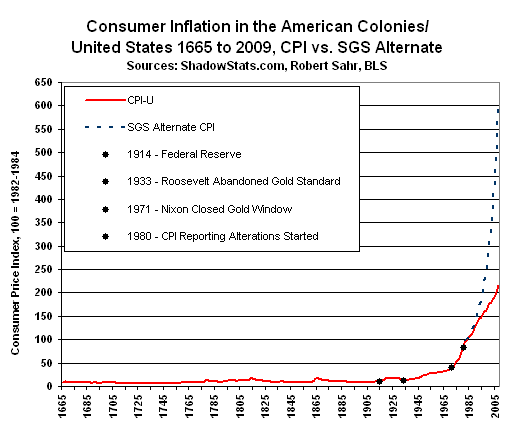

over time — not compounding like the population and related series that grow with it — I do not have any issue with using a non-log scale for the visual impact of what is happening.
Persistent year-to-year inflation (and the related compounding effect) did not take hold until post-Franklin D. Roosevelt. Additionally, the CPI level reflects purchasing power lost over time for those holding dollars, which is cumulative, and which has reached extremes (as will be discussed shortly) due to the late-era compounding effect. If my assessment is correct on where this is headed, the log-based graph shortly will look like the arithmetic-based graph, as was seen the latter months of the Weimar circumstance.
Indicated by the newly visible detail in the second graph are the regular periods of inflation — usually seen around wars — offset by periods of deflation, up through the Great Depression. Particular inflation spikes can be seen at the time of the American Revolution, the War of 1812, the Civil War, World War I and World War II (which lacked an ensuing, offsetting deflation).
The inflation peaks and the ensuing post-war depressions and deflationary periods, tied to the War of 1812, the Civil War and World War I, show close to 60-year cycles, which is part of the reason some economists and analysts have been expecting a deflationary depression in the current period. There is some reason behind 30- and 60-year financial and business cycles, as the average difference in generations in the U.S. is 30 years, going back to the 1600s. Accordingly, it seems to take two generations to forget and repeat the mistakes of one’s grandparents. Similar reasoning accounts for other cycles that tend to run in multiples of 30 years.
Allowing for minor, average-annual price-level declines in 1949, 1955 and likely 2009, the United States has not seen a major deflationary period in consumer prices since before World War II. The reason for this is the same as to why there has not been a formal depression since before World War II: the abandonment of the gold standard and recognition by the Federal Reserve of the impact of monetary policy — free of gold-standard system restraints — on the economy.
The gold standard was a system that automatically imposed and maintained monetary discipline. Excesses in one period would be followed by a flight of gold from the system and a resulting contraction in the money supply, economic activity and prices.
Faced with the Great Depression, and unable to stimulate the economy, partially due to the monetary discipline imposed by the gold standard, Franklin Roosevelt used those issues as an excuse to abandon gold and to adopt close to a fully-fiat currency under the auspices of what I call the debt standard, where the government effectively could print and spend whatever money it wanted to.
Roosevelt’s actions were against the backdrop of the banking system being in a state of collapse. The Fed stood by twiddling its thumbs as banks failed and the money supply imploded. A depression collapsed into the Great Depression, with intensified price deflation. Importantly, a sharp decline in broad money supply is a prerequisite to goods and services price deflation. Messrs Greenspan and Bernanke are students of the Great Depression period. As did Mr. Greenspan before him, "Helicopter Ben" has vowed not to allow a repeat of the 1930s money supply collapse.
Where the Franklin Roosevelt Administration abandoned the gold standard and its financial discipline for the debt standard, twelve successive administrations have pushed the debt standard to the limits of its viability, as seen now in the continuing threat of systemic collapse. Now the Obama Administration has to look at abandoning the debt standard (hyperinflation) and starting fresh.
The effect of the post-Roosevelt policies has been a slow-motion destruction of the U.S. dollar’s purchasing power, per the accompanying table, since the gold standard was abandoned in 1933. The magnitude of purchasing power lost over the decades can be lost again in a matter of days.
|
Loss of U.S. Dollar Purchasing Power |
|||
|
Through October 2009 |
|||
|
|
Since January of |
||
|
Versus |
1914 |
1933 |
1970 |
|
Swiss Franc |
-80.0% |
-80.0% |
-75.6% |
|
CPI-U |
-95.4% |
-94.1% |
-82.6% |
|
Gold |
-98.1% |
-98.1% |
-94.1% |
|
SGS-Alternate CPI |
-98.5% |
-98.1% |
-94.3% |
Please note in the above table that gold and the Swiss franc were held constant by the gold standard versus coins in 1914 and 1933. The data are from the Federal Reserve Board, Bureau of Labor Statistics and from SGS data and calculations.
"Helicopter Ben" on Preventing Deflation. Federal Reserve Chairman Ben Bernanke picked up his various helicopter nicknames and references as the result of a November 21, 2002 speech he gave as a Fed Governor to the National Economists Club entitled "Deflation: Making Sure ‘It’ Doesn’t Happen Here." The phrase that the now-Fed Chairman Bernanke likely wishes he had not used was a reference to "Milton Friedman’s famous ‘helicopter drop’ of money."
Attempting to counter concerns of another Great Depression-style deflation, Bernanke explained in his remarks: "I am confident that the Fed would take whatever means necessary to prevent significant deflation in the United States …"
As expounded upon by Bernanke, "Indeed, under a fiat (that is, paper) money system, a government (in practice, the central bank in cooperation with other agencies) should always be able to generate increased nominal spending and inflation, even when the short-term nominal interest rate is at zero."
"Like gold, U.S. dollars have value only to the extent that they are strictly limited in supply. But the U.S. government has a technology, called a printing press (or, today, its electronic equivalent), that allows it to produce as many U.S. dollars as it wishes at essentially no cost. By increasing the number of U.S. dollars in circulation, or even by credibly threatening to do so, the U.S. government can also reduce the value of a dollar in terms of goods and services, which is equivalent to raising the prices in dollars of those goods and services. We conclude that, under a paper-money system, a determined government can always generate higher spending and hence positive inflation." The full text of then-Fed Governor Bernanke’s remarks can be found at: http://federalreserve.gov/boarddocs/speeches/2002/20021121/default.htm.
Bernanke initiated his anti-deflation actions back in 2008, but they have not worked fully as advertised. While the systemic solvency crisis has been contained at least temporarily in key areas, and depositor

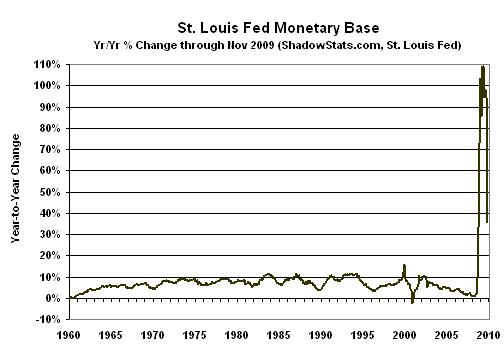
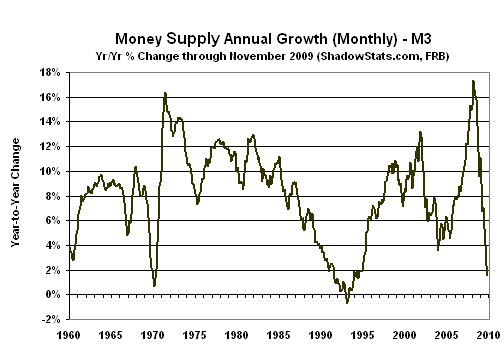
funds have not suffered heavy losses, the broad money supply now is in monthly decline, soon to be year-to-year decline, but not yet in collapse. Back in September 2008, the Fed started dropping cash from helicopters, as shown in the graphs of the monetary base. As shown in the two graphs of level and year-to-year change, Bernanke’s spiking of the monetary was extraordinary and was without precedent. As seen in the recent renewed spike in the monetary base to historic levels, the Fed has been panicking anew. The fall-off in year-to-year growth is just due to year-ago comparisons where growth also was spiking sharply. Despite a still active fleet of choppers, systemic liquidity and solvency remain in deep trouble.
The monetary base remains the Federal Reserve’s primary tool for impacting money supply growth. As has been the case for the bulk of the extraordinary expansion of the monetary base since late-August 2008 — an increase of 129% — the monetary base growth, however, has not been reflected meaningfully in money supply growth. Such remains due to banks placing high levels of excess reserves with the Fed, instead of lending the funds into the normal flow of commerce.
The SGS-Ongoing M3 estimate (the Fed abandoned reporting its broadest money supply measure, M3, back in March 2006) has been contracting month-to-month for five months through November 2009, with annual growth slowing as shown in the M3 graph. M3 appears destined to turn negative year-to-year in December 2009, on both a nominal (as displayed in the graph) and inflation-adjusted basis. Such would be a leading indicator for an economic downturn in normal times and would foreshadow a significant turn for the worse in the current, severe economic contraction during first-half 2010. As discussed in the Money Supply Special Report, the Fed always can drive the economy into a downturn, with contracting money supply, but the reverse does not always work.
Inflation and Slowing/Contracting Money Growth. The Fed’s efforts at currency debasement have been reflected in a weakening of the U.S. dollar’s value in foreign exchange markets. In theory, though, slowing or outright contraction in broad money supply growth should be reflected in slower inflation or outright deflation. As with most economic theories, however, there often are simplifying assumptions that may not be appropriate under certain circumstances. Money supply, for example, works best as a predictor of inflation in a closed system, as was seen with Zimbabwe.
In the case of the United States, however, significant dollars are held outside the country, where shifting dynamics may have significant impact on U.S. inflation. To the extent that foreign holdings of U.S. dollars are in stasis, with demand and supply in balance, then the circumstances of the simplified money supply model tend to work. The dollar’s global position, though, is not in balance, particularly with the Fed working to debase the U.S. currency: to create inflation.
One distortion up front is in the U.S. currency in circulation, as reported in the narrowest money supply measure, M1. More than half of the $860 billion reflected in recent M1 reporting is physically outside the United States in "dollarized" countries and elsewhere.
Separately, as reported by the Fed in its second-quarter 2009 flow-of-funds analysis, foreign holders of U.S. assets have something in excess of $10 trillion in liquid dollar-denominated assets that could be dumped at will into the global and U.S. markets. In perspective, U.S. M3 is somewhat over $14 trillion.
Helping to fuel those holdings, the Fed has been using the excess reserves deposited with it by U.S. banks to buy troubled mortgage-backed securities from financially stressed institutions, and some of the institutions benefitting likely are located outside the United States.
As excess dollars get pumped into the global markets, a shift in the tide against the U.S. dollar gets reflected in a weakening exchange rate, which in turn spikes dollar-denominated commodity prices, such as oil. That effect has been seen in recent months, with the result that U.S. consumer inflation has started to resurface, not from strong economic demand and a surging domestic money supply, but from distended monetary policies and a global glut of dollars encouraged by the U.S. central bank.
Demand and supply affect the U.S. dollar. Supply soars and demand shrinks with the increasing unwillingness of major dollar holders to continue holding the existing volume of U.S. currency and dollar-denominated assets, let alone to absorb new exposure.
Therein lies a significant threat to near-term U.S. inflation. Heavy dumping of the U.S. dollar and dollar-denominated assets would be highly inflationary to U.S. consumer prices. It also likely would activate heavy Fed intervention in buying unwanted U.S. Treasuries. When the Fed moves to buy Treasuries as the lender of last resort — to monetize U.S. debt well beyond anything seen to date — that also would tend to trigger renewed growth in the otherwise flagging broad money growth.
In order to get the broad money supply to grow, the federal government has to spend and borrow more money, where the Fed will have to buy large quantities of the Treasury’s securities, monetizing the federal debt. The liquidity action to date has been primarily buying otherwise illiquid mortgage-backed securities off the balance sheets of troubled banks. The domestic banks in turn have leant substantial excess reserves back to the Fed, rather than lending into the normal stream of commerce, which would spike the money supply and otherwise be something of an economic positive.
The Fed remains the U.S. Treasury’s lender of last resort. Panicked dollar selling and dumping of dollar-denominated paper assets — particularly U.S. Treasuries — likely would force the Fed’s hand in a rapid monetizing of Treasury debt.
Early Impact of Dollar Debasement. Shown in the next three graphs are powerful fundamentals that either drive U.S. inflation or reflect market expectations of the longer-term domestic inflation outlook. The currency, oil and gold markets have seen extreme volatility in the last year or so. After seeing significant selling, the dollar soared during the breaking solvency crisis, due to massive manipulation and largely covert central bank intervention, position liquidations that required U.S. dollars and some surviving safe-haven status of the U.S. currency. In tandem with the dollar’s strength, oil and gold prices fell sharply.
Now, as reflected in the monthly average value of the U.S. dollar in Swiss francs, gains seen since the historic dollar low in early-2008 have evaporated. In turn, oil prices have rebounded from their recent lows, though they still are well shy of last year’s historic high. Reflecting the inflationary pressures from a weaker dollar and higher oil prices, ongoing solvency issues for the United States, and continued dollar debasement efforts by the Federal Reserve, the price of gold has recovered recent losses and is pushing new highs. Irrespective of any near-term volatility, both dollar weakness and gold strength remain solid long-term bets.
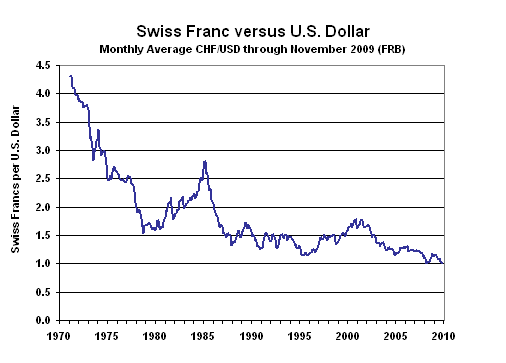
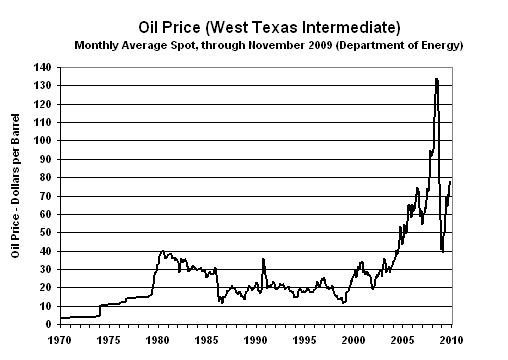
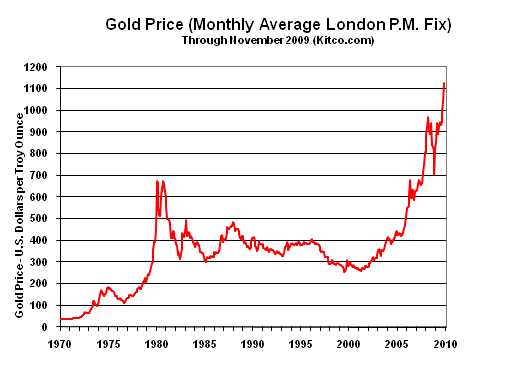
U.S. Government Cannot Cover Existing Obligations
The U.S. Treasury publishes annual financial statements of the United States Government, prepared using generally accepted accounting principles (GAAP), audited by the General Accountability Office (GAO) and signed off on by the U.S. Treasury Secretary. The 2009 statements, originally scheduled for publication this month, have been delayed to February 2010.
GAAP-accounting is what major U.S. corporations use. Such statements usually include liabilities for retired employees’ pensions and health care obligations. Yet, the Bush Administration (as likely will continue to be the case with the Obama Administration) argued that unfunded Social Security and Medicare obligations should remain off the government’s balance sheet, claiming that the government always has the option of changing the Social Security and Medicare programs. That said, there still is no political will in Washington to go public with the concept of eliminating or substantially cutting those programs.
The federal government’s GAAP-based financial statements show the actual annual fiscal deficit careening wildly out of control. Including the annual changes in the net present value of unfunded liabilities, the fully-GAAP-based annual 2008 deficit was $5.1 trillion dollars, versus the official cash-based $455 billion. The 2009 actual shortfall likely was around $8.8 trillion, instead of the official cash-based $1,417 billion. Again, the largest portion of GAAP-based versus the cash-based difference is in accounting for the net present value, and the year-to-year changes in same, for unfunded Social Security and Medicare liabilities, etc. The results are summarized in the accompanying table, showing various deficit, debt and obligation measures.
The government’s finances not only are out of control, but the actual deficit is not containable. Put into perspective, if the government were to raise taxes so as to seize 100% of all wages, salaries and corporate profits, it still would be showing an annual deficit using GAAP accounting on a consistent basis. In like manner, given current revenues, if it stopped spending every penny (including defense and homeland security) other than for Social Security and Medicare obligations, the government still would be showing an annual deficit. Further, the U.S. has no potential way to grow out of this shortfall.
As shown in the first of three graphs following the table, U.S. federal obligations are so huge versus the national GDP that the country’s finances look more like those of a banana republic than the world’s premiere financial power and home to the world’s primary reserve currency, the U.S. dollar. Total federal debt and obligations at the end of the 2009 fiscal year on September 30th, likely were close to $75 trillion, or more than five times total U.S. GDP. The $75 trillion includes roughly $12 trillion in gross federal debt, with the balance reflecting the net present value of unfunded obligations.
If not for the special position the United States holds in the world, its debt — U.S. Treasuries — likely would be rated as below investment grade, instead of triple-A. Major rating agencies have hinted at possible longer-term rating issues on Treasury securities.
A downgrade, though, is not likely, as long as U.S. Treasuries are denominated in U.S. dollars and as long as they are used as the benchmark for the triple-A rating. Such ratings usually are an opinion as to the risk of default. Treasuries denominated in U.S. dollars are not likely to face actual default, so long as the Treasury and Fed can create dollars to pay off the face amounts of the obligations. While a three-month
|
U.S. Government - Alternate Fiscal Deficit and Debt |
||||||
|
Dollars are in either billions or trillions, as indicated. |
||||||
|
Fiscal |
Formal |
GAAP |
GAAP |
GAAP |
Gross |
Total(2) |
|
2009(3) |
$1,417.1 |
$2,800.0 |
$8.8 |
$68.1 |
$11.9 |
$74.6 |
|
2008 |
454.8 |
1,009.1 |
5.1 |
59.3 |
10.0 |
65.5 |
|
2007 |
162.8 |
275.5 |
1.2(4) |
54.3 |
9.0 |
59.8 |
|
2006 |
248.2 |
449.5 |
4.6 |
53.1 |
8.5 |
58.2 |
|
2005 |
318.5 |
760.2 |
3.5 |
48.5 |
7.9 |
53.3 |
|
2004 |
412.3 |
615.6 |
11.0(5) |
45.0 |
7.4 |
49.5 |
|
2003 |
374.8 |
667.6 |
3.0 |
34.0 |
6.8 |
39.1 |
|
2002 |
157.8 |
364.5 |
1.5 |
31.0 |
6.2 |
35.4 |
|
(1) Fiscal year ended September 30th. (2) Includes gross federal debt, not just "public" debt. While the non-public debt is debt the government owes to itself for Social Security, etc., the obligations there are counted as "funded" and as such are part of total government obligations. (3) Except for the formal cash-based deficit and for the gross federal debt, which are government estimates, fiscal 2009 data are estimated by SGS. Please note that mid-year accounting redefinitions for TARP knocked off roughly $500 billion from the reported formal cash-based estimate. (4) On a consistent reporting basis, net of one-time changes in actuarial assumptions and accounting, SGS still estimates that the GAAP-based deficit for 2007 topped $4 trillion, with negative net worth of $57.1 trillion and total obligations of $59.8. So as to maintain consistency with the official GAAP statements, the "official" numbers are shown. (5) SGS estimates $3.4 trillion, excluding one-time unfunded setup costs of the Medicare Prescription Drug, Improvement, and Modernization Act of 2003 (enacted December 2003). Again, in order to maintain consistency with the official GAAP statements, the "official" numbers are shown in the table for 2004. The 2009 GAAP statement were due for release in mid-December 2009, but they have been delayed until February 2010. Link to the 2008 statements: http://www.fms.treas.gov/fr/08frusg/08frusg.pdf
|
||||||
Treasury at the moment may be safe, I would not want to bet on receiving anything close to full value on a 10-year Treasury note or 30-year Treasury bond.
As shown in the second of the three graphs, most U.S. Treasury issuance of recent years, thorough 2007, has been purchased by investors outside the United States. Not only have these investors been taking a hit in terms of the value of the U.S. dollar, but also they face meaningful devaluation risk in the near future.
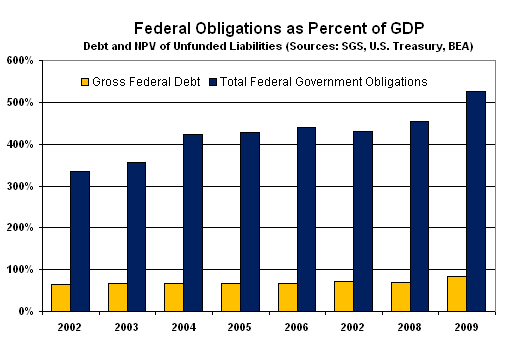
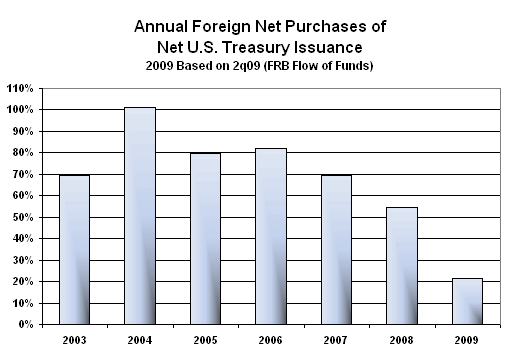
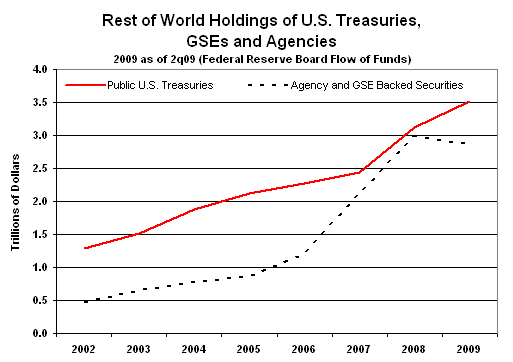
As issuance has increased along with rising hesitancy in holding U.S. Treasuries, post-crises, the portion of new issuance covered by foreign investors has started to drop off sharply. Again, the Fed remains the buyer of last resort for U.S. Treasuries, and it has the ability to operate through surrogates at home and abroad.
The graph above gives some scope of as to the size of foreign held assets issued by the U.S. Treasury, or questionably guaranteed by it. They are among a pool of over $10 trillion dollars that could be dumped in a panicked dollar selling environment.
Hyperinflationary Great Depression
Even with the government’s spending, debt and obligations running far beyond the ability of the government to cover with taxes or the political willingness of the government to cut entitlement spending, the inevitable inflationary collapse, based solely on these funding needs, possibly could have been pushed well into the next decade. Yet, the printing presses already are running, and the Fed is working actively to debase the U.S. dollar. Actions already taken to contain the systemic solvency crisis and to stimulate the economy, plus the ongoing devastating impact of a severe economic contraction on tax revenues, have set the stage for a much earlier crisis. Risks are high for the hyperinflation beginning to break in the year ahead; it likely cannot be avoided beyond 2014.
It is this environment of rapid fiscal deterioration and related massive funding needs, the U.S. dollar remains open to a rapid and massive decline and to the dumping of U.S. Treasuries. The Federal Reserve would be forced to monetize significant sums of Treasury debt, triggering the early phases of a monetary inflation. Under such circumstance multi-trillion dollar deficits rapidly would feed into a vicious, self-feeding cycle of currency debasement and hyperinflation.
Lack of Physical Cash. The United States in a hyperinflation would experience the quick disappearance of cash as we know it. In Zimbabwe, there was the back-up of a well-functioning black market in U.S. dollars, but no such back-up exists in the United States. Shy of the rapid introduction of a new currency and/or the highly problematic adaptation of the current electronic commerce system to new pricing realities, a barter system is the most likely circumstance to evolve for regular commerce. Such would make much of the current electronic commerce system useless and add to what would become an ongoing economic implosion. It also could take a number of months to become reasonably functional.
Some years back, I happened to be in San Francisco, having dinner with a former regional Federal Reserve Bank president and the chief economist for a large Midwestern bank. Market rumors that day had been that there was a run on a major bank in the City by the Bay. So I queried the regional Fed president as to what would be happening if the rumors were true.
He had had some personal experience with a run on banks in his region and explained how the Fed had a special team designed to handle such a crisis. The biggest problem he had had was getting adequate cash to the troubled banks to cover depositors, having to fly cash in by helicopters to meet the local cash flow needs.
The troubled bank in San Francisco, however, was much larger than the example cited, and the former Fed bank president speculated that there was not enough cash in the vaults of the regional Federal Reserve Bank, let alone the entire Federal Reserve System, to cover a true run on deposits at the major bank.
Therein lies an early problem for a system headed into hyperinflation: adequate currency. Where the Fed may hold roughly $200 billion in currency outside of roughly $50 billion in commercial bank vault cash, the bulk of roughly $860 billion in currency outside the banks is not in the United States. Back in 2000, the Fed estimated that 50% to 70% of U.S. dollar cash was outside the system. That number probably is higher today, with perhaps as little as $250 billion in physical cash in circulation in the United States, or roughly 1.7% of M3. The rest of the dollars are used elsewhere in the world as a store of wealth, or as an alternate currency free of the woes of unstable domestic financial conditions. Those conditions would change severely in the event of a U.S. hyperinflation.
Given the extremely rapid debasement of the larger denomination notes, with limited physical cash in the system, existing currency would disappear quickly as a hyperinflation broke.
For the system to continuing functioning in anything close to a normal manner, the government would have to produce rapidly an extraordinary amount of new cash, and electronic commerce would have to be able to adjust to rapidly changing prices.
In terms of cash, new bills of much higher denominations would be needed, but production lead time is a problem. Conspiracy theories of recent years have suggested the U.S. Government already has printed a new currency of red-colored bills, intended for some dual internal and external U.S. dollar system. If such indeed were the case, then there might be a store of "new dollars" that could be released at a 1-to-1,000,000 ratio, or whatever ratio was needed to make the new currency meaningful, but such would not resolve any long-term problems — as seen in the multiple Zimbabwe devaluations — unless it was part of an overall restructuring of the domestic and global financial and currency systems and unless the U.S. government could put its fiscal house in order.
From a practical standpoint, however, currency would disappear, at least for a period of time in the early period of a hyperinflation.
Where the vast bulk of today’s money is not physical, but electronic, however, chances of the system adapting there are virtually nil. Think of the time, work and effort that went into preparing computer systems for Y2K, or even problems with the recent early shift to daylight savings time. Systems would have to be adjusted for variable, rather than fixed pricing, credit card lines would need to be expanded daily, the number of digits used in tallying dollar-denominated transactions would need to be expanded sharply. I have had assurances from some in the computer field that a number of businesses have accounting software that can handled any number of digits.
From a practical standpoint, though, the electronic quasi-cashless society of today likely also would shut down early in a hyperinflation. Unfortunately, this circumstance rapidly would exacerbate an ongoing economic collapse.
Barter System. With standard currency and electronic payment systems non-functional, commerce quickly would devolve into black markets for goods and services and a barter system. Gold and silver both are likely to retain real value and would be exchangeable for goods and services. Silver would help provide smaller change for less costly transactions. One individual I met indicated that he had found airline bottles of scotch to be ideal small change in a hyperinflationary environment.
Other items that would be highly barterable would include bottles of liquor or wine, or canned goods, for example. Similar items that have a long shelf life can be stocked in advance of the problem, and otherwise would be consumable if the terrible inflation never came. Separately, individuals, such as doctors and carpenters, who provide broadly useable services, already have services to barter.
A note of caution was raised once by one of my old economics professors, who had spent part of his childhood living in a barter economy. He told a story of how his father had traded a shirt for a can of sardines. The father decided to open the can and eat the sardines, but he found the sardines had gone bad. Nonetheless, the canned sardines had taken on a monetary value.
Howard J. Ruff, who has been writing about these problems and issues since Nixon closed the Gold window, rightly argues that it will take some time for a barter system to be established, and suggests that individuals should build up a six-month store of goods to cover themselves and their families in the difficult times. Such is within the scope of normal disaster planning in some areas of the country (for example, I sit almost on top of the Hayward Fault).
Financial Hedges. During these times, safety and liquidity remain key concerns for investments, as investors look to preserve their assets and wealth through what are going to be close to the most difficult of times. Those who can preserve their wealth and maintain liquidity will have the ability to take advantage of extraordinary investment opportunities after the crises pass.
Gold and Silver. In a hyperinflation, gold and silver would be primary hedging tools that would retain real value and also be portable in the event of possible civil turmoil. At some point, the failure of the world’s primary reserve currency will lead to the structuring of a new global currency system. I would not be surprised to find gold as part of the new system, structured in there in an effort to sell the new system to the public.
Real Estate. Real estate also would provide a basic inflation hedge, but it lacks the portability and liquidity of gold. That could become an issue if the political environment shifted so radically that ownership of private property became impossible.
Currencies. Having some funds invested offshore — outside of the U.S. dollar — would be a plus in circumstances where the government might impose currency or capital controls. I look at the Swiss franc, the Canadian dollar and the Australian dollar as currencies likely to maintain their purchasing power against the U.S. dollar. Any suggestions here in terms of currencies, gold and silver, etc. are for holding same over the long term. Near-term price volatility remains a risk in most markets.
Taking on Debt. Inflation is supposed to be the debtor’s friend, where debtors, like the U.S. government, end up paying off their obligations in cheap dollars. A note of caution is offered here. The current circumstances are extraordinary. Borrowers should consider their ability to carry debt through extremely difficult economic times, including possible loss of employment, etc., before high inflation might kick in. Consider, too, the U.S. government recently has intervened in altering terms and conditions of mortgages. Could a radical political change end up recasting the terms of personal obligations?
TIPS (Corrected Text). The U.S. Treasury offers securities where yields and principal get adjusted regularly for the rate of inflation. In a hyperinflation, price changes can be so rapid that the principal and/or yield adjustment would lag enough so as to make the adjustments worthless. The reporting lag in calculating the adjusting CPI index — if it even could be calculated — still would wipe out investors, unless the Treasury became particularly creative and began benchmarking to spot gold or such, but nothing like that is in place.
As to the potential rapidity of price change, consider some anecdotal evidence. One story out of Weimar Germany involved buying an expensive bottle of wine for dinner. The empty bottle was worth more as scrap glass the next morning than it had been worth as a full bottle of wine the night before. Anther story involved negotiating the price and paying for a meal, before sitting down, as the price of the meal would be higher by the time it was finished.
Equities. While equities do provide something of an inflation hedge — revenues and profits get expressed in current dollars — they also reflect underlying economic and political fundamentals. I still look for U.S. stocks to take an ultimate 90% hit, peak-to-trough, net of inflation, during this period. Where all stocks are tied to a certain extent to the broad market — to the way investors are valuing equities — such a large hit on the broad market will tend to have a dampening effect on nearly all equity prices, irrespective of the quality of a given company or a given industry.
The following graph shows the year-end Dow Jones Industrial Average in current terms, as well as adjusted for SGS-Alternate Consumer Inflation. While stocks may rally based on high inflation, in inflation-adjusted terms, a bear market remains a good shot. An early-hyperinflation DJIA at 100,000 could be worth 1,500 in today’s terms.
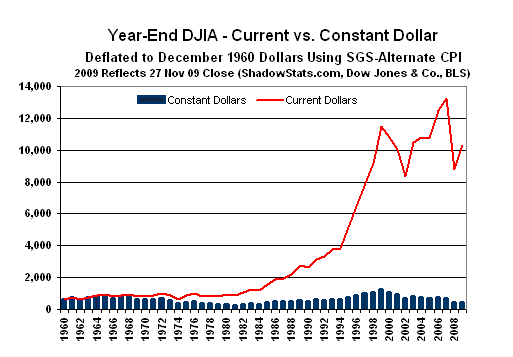
Closing Comments
Other Issues. A hyperinflationary great depression would be extremely disruptive to the lives, businesses and economic welfare of most individuals. Such severe economic pain could lead to extreme political change and/or civil unrest. What has been discussed here remains well shy of a comprehensive overview of all possible issues, but rather at least has raised some questions and touched upon some likely consequences. No one can figure out better than you the peculiarities of this circumstance and how you, your family and/or your business might be affected. Using common sense remains the best advice I can give.
These matters will continue to be expanded upon in SGS Commentaries, as circumstances and subscriber reactions dictate.
I extend by deep thanks to the various readers who have raised questions and provided ideas and material. As always, please feel free to offer your comments or raise your questions by e-mail to johnwilliams@shadowstats.com.
Recommended Further Reading
- Related SGS Special Reports:
Money Supply Special Report (August 3, 2008)
Depression Special Report (August 1, 2009)
Consumer Liquidity Special Report (September 14, 2009)
- Recommended Outside Reading:
As mentioned elsewhere in the text, and as recommended to subscribers last year:
Fiat Paper Money, The History and Evolution of Our Currency
by Ralph T. Foster (Privately Published)
2189 Bancroft Way, Berkeley, CA 94704
E-mail: tfdf@pacbell.net
Ralph Foster continually is updating and expanding his volume.